Well, I soldiered on to the end of Isaac Asimov’s Foundation and around page 135 (of 172) a woman appears! She is the young and beautiful wife of a petty tyrant with big aspirations who married her only because her father has money and power in the Empire. She, of course, is an unhappy woman with a sharp tongue, always pestering her husband with how dumb he is and threats of telling her father. She suggests she will leave her husband and he threatens her with violence:
‘Well, now, I’ll tell you what my lady. Perhaps you would enjoy returning to your native world. Except that, to retain as a souvenir that portion of you with which I am best acquainted, I could have your tongue cut out first. And,’ he rolled his head, calculatingly, to one side, ‘as a final improving touch to your beauty, your ears and the tip of your nose as well.’
But don’t worry, it all comes right when he gives her some fancy jewelry like no other that any woman at the big party will have that night. She immediately shuts up and starts admiring herself in the mirror, then goes away happy.
And very late in the book almost at the end, we are told that war with another planet will be avoided in part because the small, nuclear powered household appliances they have been buying from the Foundation for several years will begin running out of power (the appliances all have tiny individual nuclear power generators like a fancy battery). This other world will not go to war with the Foundation because they won’t be able to get any more of the things they have come to rely on. The women will start complaining when their nuclear knives no longer work, when their stoves begin to fail and when their washers stop doing a good job at cleaning.
Oy.
Foundation is made up of a collection of five short stories that appeared between 1942 and 1944 in Astounding Magazine. They were collected together into a book and published in 1951. This became the first book in the Foundation Trilogy which later expanded with prequels and sequels and is now known as the Foundation Series.
The prose is fairly pedestrian and the plots aren’t all that interesting. Even though the stories deal with a series of crises, there isn’t really any threat of failure because, as we are told over and over, it was all already predicted by Hari Seldon, the great psychohistorian and cruncher of numbers. Where’s the tension when predestination is at play?
One of the more interesting things about the stories is how the Foundation, made up of a bunch of scientists, in order to survive and conquer, has turned science into a religion with priests and rituals and all the trappings. The priests and acolytes are trained in science enough to be able to maintain things like power grids and perform minor “miracles” but not know enough to actually “do” science on their own. They pretty much believe the whole religion scenario. The high ranking muckity-mucks are actual scientists who are in on the scam, constantly working to perpetuate it and to spread the Foundation’s dominance across their little corner of the galaxy through it. Domination by science through the vehicle of religion.
My main amusement while reading the book, however, was the invented slang and swearing. How can things like “son-of-a-spacer” and “I don’t care an electron” not arouse a giggle or at least a smirk? And exclamations like “space knows!” and “by space!” pepper conversations and is intended to sound so futuristic and scientific. It was almost worth it just for that. Almost.
Still, though I found it all a giant dud, I am glad to have read it. At least I know what it is about now even if I don’t understand why it’s so popular and considered a classic. Maybe the other books sort it out better but I have no interest in reading them so I guess my understanding will remain incomplete. I’m okay with that.
Filed under:
Books,
Reviews,
SciFi/Fantasy Tagged:
Isaac Asimov 

If you’ve been following the history of the Asbury Park Comicon, which opened only a year ago in March of 2012, you know it’s been a strange, yet rather astonishing ride, but imagine how much stranger it must be for founder and indie comics creator Cliff Galbraith. What started in a bowling alley turned music venue and local hangout, Asbury Lanes, has become a major testament to demand for Comic Cons in New Jersey, and also a statement about the desires and tastes of con-goers who have relished the indie vibe of Galbraith’s brainchild. After a highly successful second Con in September of 2012, Galbraith announced that the Con would move to the much larger and even more historic venue of Asbury Park Convention Hall for its third event on March 30th 2013.
Then Superstorm Sandy struck, devastating the seaside town of Asbury Park, leaving the future of the Con in question. Against some difficult odds, the Con forged ahead, and Galbraith faced another kind of storm- media frenzy- over the upcoming Con. It’s fair to say that his phone has been ringing off the hook as local press as well as The New York Times have been trying to get the scoop on what looks to be a growing New Jersey institution as Asbury Park Comicon nears its biggest event yet. Dozens of prominent guests will be flanking this full-blown gala of a Con, and the Con will also be featuring panels and contests. Galbraith hasn’t had a moment’s rest since all this started more than a year ago, and he finished up several other interviews just in time to answer some questions about all this Con madness, and how it fits into his own life, for The Beat.
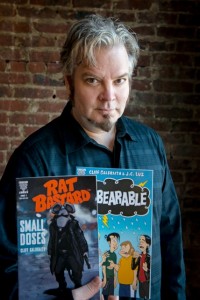
Hannah Means-Shannon: Can you remember the moment when the idea for starting a Comic Con in New Jersey first occurred to you? How wild did the idea seem at the time?
Cliff Galbraith: Maybe I’ve always wanted to run my own con. I’ve been to enough of them over the last few decades. A lot of them were pretty shabby. Customer service was pretty awful. I’ve been to cons where the promoter never came around and so much as said hello or how’s it going. Some were downright rude or deceitful.
On a Sunday in the summer of 2011, I stopped into the bowling alley/rock club Asbury Lanes — they were having a little record fair in there. I knew a few of my friends would be there selling and buying records or drinking beers so I figured I’d get away from my drawing table for the afternoon and see what was happening. My friend and neighbor Robert Bruce was selling an assortment of rare rock and jazz records and some underground comix. I remember looking at someone rooting through a white box of records, and I turned to Rob and I said “Where else have I seen somebody doing that? Reminds me of people at a comic convention digging through long boxes.” We laughed, but I walked around a bit and I kept thinking about it. If they could sell records in this place, why not comics? My friend Jenn Hampton was the manager, so I asked her if we could have a comic con at the Lanes. Nine months later we had the first Asbury Park Comicon.
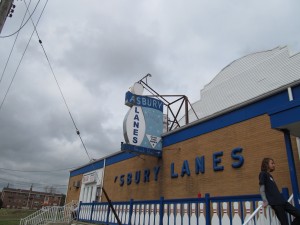
HM-S: What’s the strangest task you’ve ever had to do in order to get a Con running or keeping it on track?
CG: Partner with Rob Bruce! We’re friends, but business-wise we’re been very independent, lone wolves. But it’s been a great experience and there’s absolutely no way I could’ve done all of this or come up with all the solutions on my own. It’s been Cliff and Rob’s Excellent Adventure.
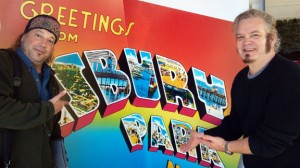
[Rob Bruce and Cliff Galbraith]
HM-S: Why Asbury as a location for the Con?
CG: People launch cons in New Jersey all the time. Some have been going on for years, but they don’t grow. I think the secret ingredient in throwing a Con is location — pick a fun destination. That’s really what set San Diego up for success early on. Who didn’t want to go somewhere with beautiful weather with plenty of bars, restaurants, hotels, a beach? That’s enticing.
So there needs to be something other than the Con once you walk outside. That’s my standard. I don’t want to go to some Con near an airport or far away from everything. I don’t want to go to some little hotel hermetically sealed in away from the world. Lots of Cons are downright depressing. They have no personality. Just putting a bunch of artists and dealers in a room and charging admission doesn’t make it fun.

[The Asbury Park Boardwalk at dusk]
HM-S: What were reactions like to the first Con at Asbury Lanes?
CG: Everyone had a great time. Most people sold lots of books. I was stunned. I just wanted to put on a little event and not screw up, just have a fun day. But the venue was a real hit. The exhibitors who’d never been to Asbury Park, who’d never been to Asbury Lanes fell in love with it. I’m spoiled, the Lanes are part of my world, but it’s really a cool old place. And there’s a bar. We played old punk tunes and Serge Gainsbourg, Nelson Riddle, soul, and stoner rock. It was more like a party — with comics.
HM-S: What obstacles did you face launching that first Con at the Lanes?
CG: It’s always tough at first to get someone with a name to attract fans. I think the first guy I called was Evan Dorkin. I always dug his work, and I’d known him for years — but more importantly he was someone who would get what I was trying to do. Evan and Sarah Dyer jumped right in. Then they told Steph Buscema. Jamal Igle was another old friend, so I contacted him early on. Those guys trusted me — that was important. But getting talent can be tough early on. Then there’s talent that doesn’t show up, there are flakes in this business and it just goes with the territory.
The biggest shock was that two months before our first Con, Asbury Lanes was sold. I know it sounds crazy, but I never got a written contract. I made a deal with my friend who was the manager. At one point, she didn’t know if she was going to still have a job or whether the new owners would honor our deal or want more money. It was scary, because this was our first time and if we screwed this up nobody would ever trust us again. It all worked out and it was a great day.

[APCC at the Asbury Lanes]
HM-S: What’s your personal philosophy behind Comic Cons?
CG: Don’t be boring. Don’t be predictable. Don’t call yourself a Comic Con and fill the bill with wrestlers, actors, and other people who have nothing to do with comics. Respect and honors those who make comics, especially those who came before us. I see a lot of bullshit at cons and I just don’t get it. If somebody wants an autograph of somebody from Twilight or some guy who played a storm trooper 30 years ago — that’s their business, but it really has nothing to do with comics. It detracts and devalues comics as something that is supposed to be celebrated. My feeling is if you’re not here for the comics then shove off. Go to a horror con, go to a sci-fi con.
HM-S: Why do you think we need Comic Cons, as a society?
CG: When my parents were kids the big thing was the circus coming to town. That’s disappeared, and now we have the Comic Con coming to town. Look at every city — there’s a con everywhere. People love it — its like Woodstock, Lollapalooza, county fair, chili cook-offs, boat shows, car shows, record fairs, film festivals, people want to get together with those who share their passion. They want to spend a day with their kids, meet new friends, make a discovery. It’s an amazing social phenomenon, and it’s in its infancy.
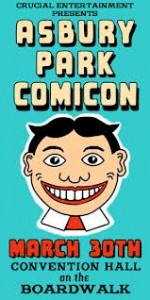
HM-S: What did you grow up reading? Any favorite comics or characters?
CG: My mom grew up in a candy store in Newark, N.J., and she spent her time drawing pictures of movie stars from magazines that were on the newsstand. She also loved comics. She introduced me to Superman when I was about four years old. She also taught me to draw. She got me a subscription to SUPERBOY and I looked forward to those comics every month. Then one day when I was getting a haircut, I picked up a copy of FANTASTIC FOUR that was in the barber shop — this was around 1965. The Kirby art kind of creeped me out at first, but I was fascinated. Joe Kubert’s HAWKMAN was a favorite. Of course BATMAN. CREEPY, EERIE, FAMOUS MONSTERS and hot rod magazines with stuff by Ed Roth and George Barris. I also read a lot of science fiction — it was a pretty classic age with Asimov, Arthur C. Clarke, and I read Pierre Boulle’s Planet of the Apes after seeing the movie. I graduated from super heroes to MAD. Then National Lampoon. At some point I found some underground comix in a head shop in Menlo Park, N.J. — they blew my teenage mind. Then Heavy Metal Magazine and Punk Magazine completed the process of completely warping my mind.
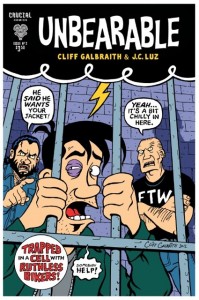
HM-S: What are your biggest influences as a comics creator?
CG: More of MAD than I used to acknowledge. I think it was an early influence in the way I saw a lot of stupid things in society. It was much tougher on politicians and corporations back in the 60′s and 70′s. I would try to draw like Mort Drucker when I was a kid. Kirby is an influence when I’m feeling lazy, when I think I’ve done enough — I think about the amount of work he put out in a day and I’m embarrassed. He keeps me going back to do a bit more before turning out the lights. I love Moebius. Bernie Wrightson, Richard Corben, Crumb, Rick Griffin, Jack Davis. I go back to Will Eisner when I get stuck on a drawing that’s not working — I’m still learning from looking at his drawings, I get answers from his panels. But when I created Partyasaurus, Beachasaurus, and all the Saurus characters back in the 80′s, I did some sort of R.O. Bleckman thing with the wiggly, broken lines. It was very successful, but I never revisited that style again.
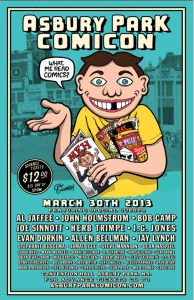
HM-S: It’s been a winding road for you career-wise. How does Con creating fit into your life, looking back?
CG: I came back to comics after ten years — at one point I was in really bad shape with Lyme disease, but that’s a whole other story. I started making RAT BASTARD comics again, just selling them at cons. I didn’t even go through Diamond — I just wanted to put something out and do some cons. Then I started working with my wife on UNBEARABLE, a totally different style but a lot of fun to draw. I was finally getting back into it, making comics. I had a few issues written I was drawing consistently and then this damn Asbury Park Comicon came along. The first one wasn’t too bad, but now with a much bigger venue, more guests, more exhibitors, ads, making a TV commercial, doing interviews with newspapers, and building a website, designing posters, it became a full time job. I didn’t realize it at first, but I sacrificed my art to build the Con. Which is okay, since April 1st I’m back at the drawing board and making comics again.
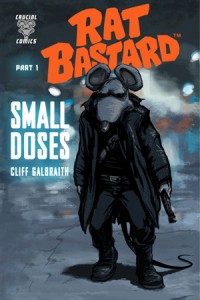
HM-S: Asbury Park was pretty hard hit by Superstorm Sandy. What was your own experience of the storm like?
CG: The other day I found pictures of my wife Judie and I at Convention Hall on the balcony making silly faces trying to stand up against the wind the day before the storm. I felt embarrassed that we were joking about it and twenty-four hours later there would be so much devastation. We could’ve have known, but I couldn’t look at those pictures. The fact that Convention Hall is still standing is amazing, but it did sustain a lot of damage.
My own experience with the storm was terror. There’s three giant pine trees in my yard that I was certain would crush us in the night. I felt like the roof on our house would be torn off any minute the whole time. We had no power for two weeks. We tried to stay in our home and tough it out with no power. I could draw during daylight. We had little parties with the neighbors and pooled our resources. After 7 or 8 days, it got too tough. It was cold. There wasn’t much to do once the sun went down. We had to go stay with my parents. But after a few days, I felt like I should be putting Led Zeppelin posters up in the basement — in other words, I felt like I was a teenager again. My parents were great about it, but you really can’t go back and live with your parents.
We were fortunate — we got to go back to our house and it was like nothing had happened other than we had to restock our refrigerator. But only two miles east of us looked like an A-bomb had been dropped. A lot of our friends suffered from that storm. We’ll be doing several things at Asbury Park Comicon to raise money for some of the nonprofits in our area and keep the focus on Sandy victims.
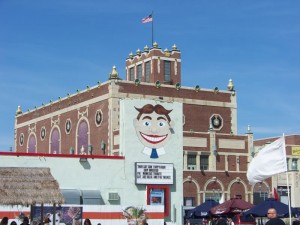
[The Asbury Convention Hall, site of APCC 2013]
HM-S: Were you afraid that damage from Superstorm Sandy might put the kaibosh on Asbury Park Comicon this year?
CG: It actually did. The building was going to be closed down by the city or something. We were told we needed to start thinking about an alternate site. It got pretty bleak. We looked into moving the con to Monmouth Racetrack, or one of the schools in Red Bank. We were desperate. And then I got a call late one night and they told me we were back in Convention Hall.
HM-S: What’s going on with Asbury Convention Hall? I hear it may not host events in the future after May.
CG: It’s an old building. It’s taken a beating. It had issues before the storm. So now it’s just better to shut down completely and get everything done once and for all. May 1st, it will be shuttered. We may be one of the last events there. This is a big thing for us to throw a con there — we grew up walking through the Grand Arcade from the boardwalk. I saw The Clash there, boxing, roller derby. To see our event on that marquee is like a dream come true — and it almost didn’t happen.
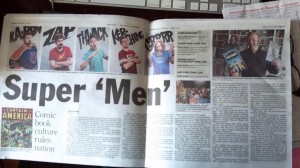
[Asbury Park Press covers COMIC BOOK MEN and Galbraith's upcoming Con]
HM-S: What’s up for Asbury Con in the future? Is it going to become an even bigger Jersey Con?
CG: We’ll know in a few weeks what the renovation schedule is for Convention Hall. We’d like to announce the dates for 2014 at this the con next week, but I don’t know if that’s quite possible by March 30th. But we’d like to move to late April and do a two day Con. The Berkley Hotel has a series of ballrooms — it’s like The Shining in there. I spoke to them last week. I’d like to keep this show in Asbury Park. Again, it’s the location that really makes a Con special. We’re planning on including more venues, galleries, etc. in the Con. Maybe a cosplay parade on the boardwalk. Put some of the bigger panels in the Paramount Theater.
We also have another big Con in the works for June 2014, but we haven’t finalized the date or exact venue. We’ve floated the ideas with a few comic industry people and we’ve gotten good feedback. The location will surprise a lot of people at first, but it makes sense geographically.
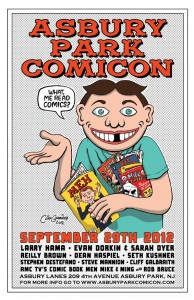
[Poster art for APCC#2 in 2012]
HM-S: What changes had to be made in the planning process of the con to move it from Asbury Lanes to the Convention Hall this time?
CG: Besides the amount of time Rob and I had to put into it, I’d say the next thing would be the amount of money it takes to launch an event this size. People have no idea what goes into a show like this. Now we’re into things like insurance, security, lighting, sound systems, putting guests in hotels, meals, travel, advertising — the expenses pile up quickly. This is no longer a fun little get-together at the Asbury Lanes with some comics and a few beers, this is a serious business venture.

[Memorable image from APCC #2 in 2012 with Evan Dorkin, Cliff Galbraith, Dean Haspiel, and Larry Hama]
The most important thing I’ve learned about running a show this size is we can’t do it on our own. We had a lot of help. Guys like Danny Fingeroth, Dean Haspiel, Seth Kushner, Chris Irving, Mark Mazz, Dave Ryan, all got us guests that we never would’ve gotten on our own. Eric Grissom built us a great website. Stu Wexler made a TV commercial — and nobody asked for anything in return. Mike [Zapcic] and Ming [Chen] from Comic Book Men have been promoting us for months on their podcast. The people who run Convention Hall have been amazing. They all just want us to succeed — we’ve got some great friends in our corner. We’ve also got some great guests: Al Jaffee, Herb Trimpe, John Holmstrom, Bob Camp, Don McGregor, Jamal Igle, Jay Lynch, Evan Dorkin, Sarah Dyer, Mark Morales, Stephanie Buscema, and Batman producer Michael Uslan. Then there’s a whole indie crew like Box Brown, Josh Bayer, Mike Dawson, Steve Mannion, and lots of others.
I’m really fortunate to be able to do this. To have gotten my health back, to be making comics again and to put on events with so many remarkable people. Sure it’s a lot of work, but I’m having the time of my life!
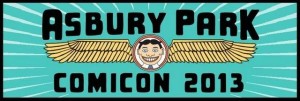
HM-S: Cliff, I don’t know how you found the time to give us such a detailed insight into your own personal journey envisoning the Asbury Park Comicon with only a few days to go until the biggest APCC yet. But we appreciate your willingness to talk about it so openly and thanks for bringing a Con of this caliber to New Jersey.
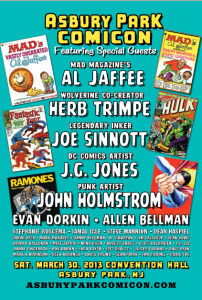
Hannah Means-Shannon writes and blogs about comics for TRIP CITY and Sequart.org and is currently working on books about Neil Gaiman and Alan Moore for Sequart. She is @hannahmenzies on Twitter and hannahmenziesblog on WordPress.

I was asked by a fantasy and science fiction survey what I thought were the weaknesses of the two genres. This is a bit like being asked in a job interview to identify your own personal weaknesses – one doesn’t want to admit to anything. But in the end I replied ‘Poor characterisation and an over-reliance on magical and scientific hardware.’ I don’t think this was unfair. As a teenager I gobbled up Isaac Asimov’s ‘Robot’ and ‘Foundation’ books, and Arthur C. Clarke’s many and various space odysseys, but what I loved was the vast sweep of the black canvas they both painted on – prickling with stars and smudged with dusty, embryonic galaxies. Against that background, the human characters in their books were unmemorable. I’m trying right now, and I can’t think of even one of their names.
As for fantasy, the same thing applies. The world is often more important than the characters. I don’t think I would recognise Colin and Susan from Alan Garner’s brilliant early fantasies, if I saw them in the street. Even in ‘Lord of the Rings’, characters are more often conveniently defined by their species (elf, dwarf, hobbit etc) than by personality. Could you pick Legolas from an identity parade of other elves, or Gimli from a line-up of other dwarfs?
You have several wonderfully memorable science-fiction/fantasy characters on the tip of your tongue at this very moment, I can tell, and you are burning to let me know. I can think of a notable exception myself: Mervyn Peake’s cast of eccentrics in the Gormenghast books. I’ll look forward to your comments... But moving swiftly on, I began to think about memorable characters in children’s fiction – which as a genre, like science fiction and fantasy, tends to be strong on narrative. Does children’s fiction in general, I wondered, have characters that walk off the page?
So here, in no particular order, is a partial list. Mr Toad. The Mole and the Water Rat. Winnie the Pooh, Eeyore and Tigger. William. Alice. The Red Queen. Oswald Bastable and Noel Bastable. Arrietty, Homily and Pod. Mrs Oldknowe. Dido Twite. Patrick Pennington. Mary Poppins. Mowgli. Long John Silver. Peter Pan. Ramona. Huck Finn. Jo, Meg, Beth and Amy. Puddleglum. Pa, Ma, Laura and Mary. Stalky. Moomintroll, the Snork Maiden and the Hemulen...
All of these characters, I would argue, are so strongly drawn that once you have met them you will never forget them. I will bet that for each of the above names (so long as you’ve read the books) you knew instantaneously who I meant, and had a picture of them in your head and the ‘flavour’ of them in your mind, just as if they were real people. These characters have a life beyond the page: not only is it possible to imagine them doing other things besides what their authors have described, it’s almost impossible not to believe that in some sense they possess a sort of independent reality.
There are many good books in which characterisation is not very important. Fairytales have always relied on standard ‘types’: the foolish younger son whose good heart triumphs, the princess in rags, the cruel queen, the harsh stepmother, the weak father, the lucky lad whose courage carries him through. This is because fairytales are templates for experience, and they are short: we identify with the hero, and move on with the narrative. Fairytales are not about other people: they are about us.
But the crown of fiction is the creation of new, independent characters. Though Mr Toad may share some characteristics with the boastful, lucky lad of Grimm’s fairytale ‘The Devil with the Three Golden Hairs’, he is nevertheless gloriously and individually himself. Huck Finn is more than a poor peasant boy or a woodcutter’s son. Children’s fiction is a fertile ground in which such characters can flourish.
Visit Katherine's website at www.katherinelangrish.co.uk



 Philadelphia Weekly
Philadelphia Weekly 
















[...] The Beat has a nice interview with indie comics creator Cliff Galbraith on founding and running the relatively new Asbury Park Comicon. I especially liked this quote: [...]